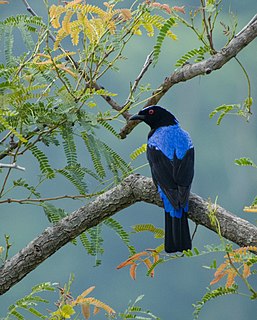
Gorillas are ground-dwelling, predominantly herbivorous apes that inhabit the forest of central Sub-Saharan Africa. The genus Gorilla is divided into two species: the eastern gorillas and the western gorillas, and either four or five subspecies. They are the largest living primates. The DNA of gorillas is highly similar to that of humans, from 95 to 99% depending on what is included, and they are the next closest living relatives to humans after the chimpanzees and bonobos.

The flat-headed cat is a small wild cat native to the Thai-Malay Peninsula, Borneo, and Sumatra. It is an Endangered species, because the wild population probably comprises fewer than 2,500 mature individuals, with small subpopulations of no more than 250 adults. The population inhabits foremost wetlands, which are being destroyed and converted. For these reasons, it is listed on the IUCN Red List since 2008.

The Baikal teal, also called the bimaculate duck or squawk duck, is a dabbling duck that breeds in eastern Russia and winters in East Asia.

The lesser adjutant is a large wading bird in the stork family Ciconiidae. Like other members of its genus, it has a bare neck and head. It is however more closely associated with wetland habitats where it is solitary and is less likely to scavenge than the related greater adjutant. It is a widespread species found from India through Southeast Asia to Java.

The Asian fairy-bluebird is a medium-sized, arboreal passerine bird.

The Dipterocarpaceae are a family of 16 genera and about 695 known species of mainly tropical lowland rainforest trees. The family name, from the type genus Dipterocarpus, is derived from Greek and refers to the two-winged fruit. The largest genera are Shorea, Hopea, Dipterocarpus, and Vatica. Many are large forest-emergent species, typically reaching heights of 40–70 m, some even over 80 m, with the tallest known living specimen 93.0 m tall. The species of this family are of major importance in the timber trade. Their distribution is pantropical, from northern South America to Africa, the Seychelles, India, Indochina, Indonesia, and Malaysia. The greatest diversity of Dipterocarpaceae occurs in Borneo. Some species are now endangered as a result of overcutting, extensive illegal logging, and habitat conversion. They provide valuable woods, aromatic essential oils, balsam, and resins, and are a source for plywood.

The western lowland gorilla is one of two subspecies of the western gorilla that lives in montane, primary and secondary forest and lowland swampland in central Africa in Angola, Cameroon, Central African Republic, Republic of the Congo, Democratic Republic of the Congo, Equatorial Guinea and Gabon. It is the nominate subspecies of the western gorilla, and the smallest of the four gorilla subspecies.

The southern white-fringed antwren is an insectivorous bird in the antbird family Thamnophilidae. It is a resident breeder in tropical South America from Colombia southeast to the Guianas and Brazil.

The black-throated trogon, also known as yellow-bellied trogon, is a near passerine bird in the trogon family, Trogonidae. Although it is also called "yellow-bellied trogon" it is not the only trogon with a yellow belly. It breeds in lowlands from Honduras south to western Ecuador and northern Argentina.

Epermeniidae or the fringe-tufted moths is a family of insects in the lepidopteran order with about 14 genera. Previously they have been divided in two subfamilies Epermeniinae and Ochromolopinae but this is no longer maintained since the last group is probably hierarchically nested within the first. They are presently placed in their own superfamily but have previously been placed among the Yponomeutoidea or Copromorphoidea with which they share some features. Their systematic placement among the apoditrysian group "Obtectomera" is however uncertain. They show some morphological similarities to the "plume moths", for example the wing fringe has similar groups of scales. There are also some similarities to Schreckensteinioidea, for example spiny legs and at least in some species an open-network cocoon. The genus Thambotricha from New Zealand may be the sister group of all other extant members. The most important genera are Epermenia, Ochromolopis and Gnathifera. The group has been extensively revised and catalogued by Dr Reinhard Gaedike.

The streak-headed mannikin also known as the streak-headed munia, is a small estrildid finch. Some taxonomists consider ssp. leucosticta a distinct species.
Nymphargus balionota is a species of frog in the family Centrolenidae. It is found in the Andes of Colombia and Ecuador. Common names Mindo Cochran frog and mottled glassfrog has been coined for it.
Pristimantis variabilis is a species of frog in the family Craugastoridae. It is found in the lowland Amazon rainforest and Andean slopes in southern Colombia, eastern Ecuador, eastern Peru, and western Brazil. The specific name variabilis refers to the variable dorsal coloration of this frog. Common name variable robber frog has been proposed for it.

The mantled hawk is a South American species of bird of prey in the family Accipitridae.

The black-winged flycatcher-shrike is a species of bird in the flycatcher-shrike genus, Hemipus. It is usually placed in the Vangidae. It is found in the Malay Peninsula and the Greater Sunda Islands. Its natural habitats are lowland forests and sometimes swamps and mangroves. The International Union for Conservation of Nature (IUCN) has assessed it as being of least concern.

Protodeltote pygarga, the marbled white spot, is a species of moth of the family Noctuidae. It is found in the Palearctic realm.

Paidia is a genus of moths in the family Erebidae erected by Jacob Hübner in 1819.

Tirumala petiverana, the blue monarch, African blue tiger or dappled monarch, is a butterfly of the family Nymphalidae. It is found in tropical Africa. The habitat consists of Afromontane, lowland and riverine forests.

Paidia rica is a moth of the family Erebidae. It was described by Christian Friedrich Freyer in 1858. It is found in southern and central Europe.
The Vietnam ferret-badger(Melogale cucphuongensis) is a member of the family Mustelidae native to Vietnam. It was described in 2011 and is known from only two specimens.















